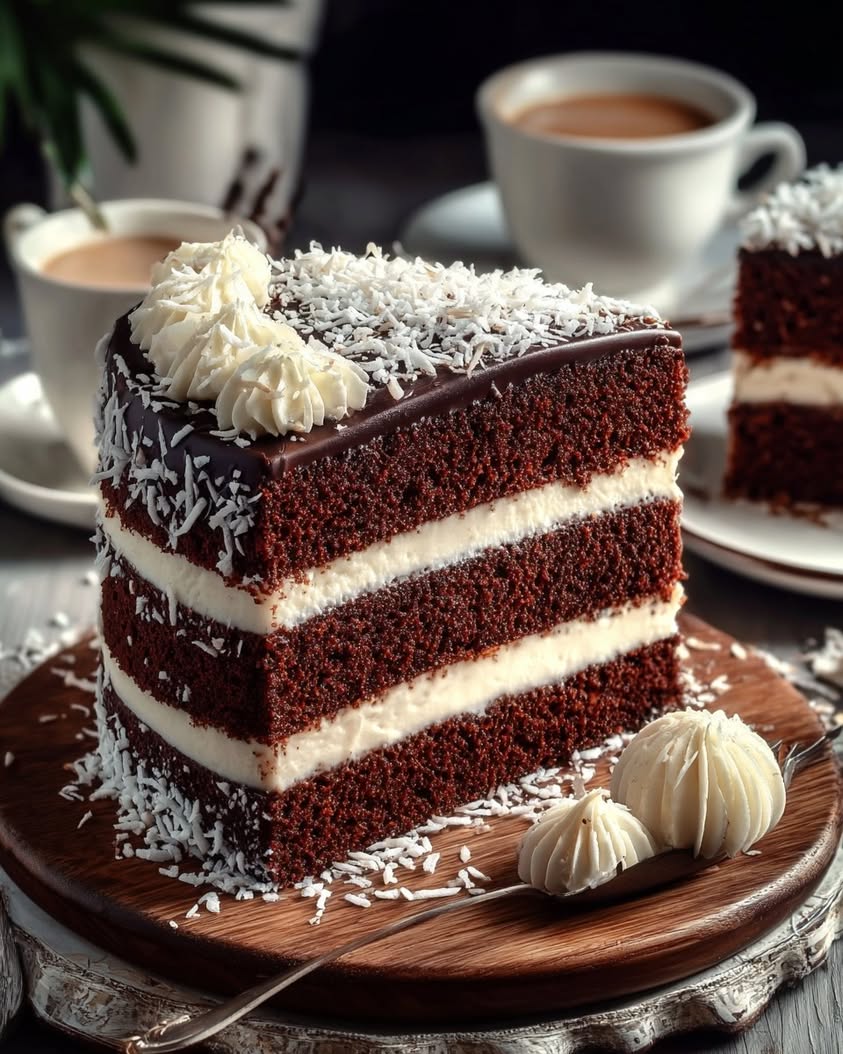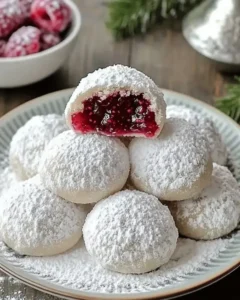Delicious Chocolate Cake Recipe with Coconut Filling and Frosting: The Perfect Indulgence
Imagine biting into a rich, moist chocolate cake that melts in your mouth, infused with the exotic sweetness of coconut. Our Chocolate Cake Recipe with Coconut Filling and Frosting brings a tropical twist to the classic chocolate cake, creating an irresistible flavor combination. This cake is perfect for celebrations or simply to enjoy on a delightful afternoon with a cup of coffee or tea. Whether you’re a seasoned baker or a beginner, you’ll find this recipe achievable and rewarding, promising a beautiful and delicious dessert each time.
The interplay between the decadent chocolate layers and the sweet coconut filling and frosting is nothing short of divine. The chocolate brings depth and a luxurious richness, while the coconut adds lightness, creating a balanced treat that’s not overly sweet but perfectly satisfying. As you savor each bite, you’ll appreciate the texture too, from the creamy frosting to the tender cake crumb.
Quick Recipe Highlights
- Flavor Profile: This cake combines deep, earthy chocolate with sweet, nutty coconut, providing a sophisticated palate that is both comforting and exotic.
- Texture: Expect a moist, tender cake with silky smooth frosting and a soft, luscious coconut filling that melts in your mouth.
- Aroma: The aromatic profile features rich cocoa notes with fresh and creamy coconut scents that create an inviting and addictive dessert experience.
- Visual Appeal: This cake promises a striking visual with its dark chocolate layers contrasting against the snowy coconut frosting, ensuring it catches the eye at any gathering.
- Skill Level Needed: Intermediate baking skills are required, including techniques like creaming butter and sugar, and accurately measuring dry ingredients.
- Special Equipment: Ensure you have a standing mixer or hand mixer for the batter and frosting plus round cake pans for even baking.
Recipe Overview
- Difficulty Level: Intermediate – The recipe involves multiple steps such as preparing a batter, heating the frosting, and layering, which require careful attention to detail.
- Category: Dessert – Perfect for a sweet ending to any meal or as a centerpiece for celebratory cake spreads.
- Cuisine: A fusion of classic dessert styling with tropical flair, this cake draws influence from traditional chocolate cakes and coconut-infused Caribbean pastries.
- Cost: With most ingredients being pantry staples like flour, sugar, and cocoa, the overall cost is moderate, with splurges for fresh coconut and quality chocolate.
- Season: Ideal for any season but especially enjoyable during spring and summer when lighter, refreshing flavors are favored.
- Occasion: Perfect for birthdays, anniversaries, and festive holidays, where the layers symbolize layers of joy and celebration.
Why You’ll Love This Recipe
Taste and texture appeal: You’ll fall in love with the luscious blend of rich chocolate and creamy coconut from the first bite. It’s indulgence in simplicity, bringing together two beloved flavors in perfect harmony. The moist and tender texture of the cake paired with the creamy consistency of the frosting makes for a truly satisfying dessert experience.
Convenience and preparation benefits: This recipe is straightforward and manageable, even if you’re juggling several other tasks. It requires a few mixing bowls and basic kitchen tools, meaning minimal cleanup afterwards. Plus, steps like making the batter can be done in batches, allowing you to break down the process over an afternoon or evening.
Nutritional advantages: While indulgent, this Chocolate Cake Recipe with Coconut Filling and Frosting also provides nutritional benefits. Coconut contains essential nutrients like manganese and medium-chain triglycerides that support metabolism and brain function. Substituting regular flour for almond flour can enhance its nutritional profile further.
Social and entertaining value: Imagine serving this cake at a family gathering or a friend’s dinner party. Its universal appeal is bound to spark conversations and compliments, making it a social centerpiece. The unique blend of flavors also makes it a fun conversation starter.
Cost-effectiveness and accessibility: Using basic pantry ingredients makes this cake economically friendly. Ingredients like cocoa powder and flour are cost-effective, and even specialty items like coconut are widely available. Whether shopping at a high-end grocery store or a local market, finding the elements for this cake is simple and budget-friendly.
Historical Background and Cultural Significance
The origin story of the Chocolate Cake Recipe with Coconut Filling and Frosting is a delightful one. Chocolate cake has been a cherished dessert for centuries, with roots steeped in European baking traditions. It was only more recently that bakers began experimenting with fillings, adding layers of flavor and creating more multidimensional cakes.
Culturally, chocolate cake has become a global symbol of celebration and indulgence. In regions like the Caribbean, where coconut trees are abundant, the marriage of chocolate and coconut was a natural progression, blending local ingredients with time-honored dessert traditions.
Over the years, this recipe has evolved significantly. Originally, coconut might have been used sparingly, grated freshly for toppings. Today, the use of coconut is diverse, ranging from milk and cream to desiccated flakes and oil, allowing for more creative culinary expressions of the classic chocolate cake.
In terms of regional variations, while the basic chocolate cake recipe remains intact, ingredients like spices or nuts might be incorporated in different locations. For instance, in the Caribbean, you might find hints of rum or cinnamon joining the mix, adding additional warmth and depth to the tropical coconut infusion.
Ingredient Deep Dive
Cocoa Powder: As a staple in chocolate desserts, cocoa powder dates back to ancient Mayan times, when it was revered for its rich taste and energizing properties. Modern cocoa powder, available in alkalized or natural forms, reacts differently in baking depending on the recipe’s leavening agents. Alkalized cocoa, often called Dutch-process, offers a smoother, less acidic taste perfect for this cake, enhancing its deep, chocolate flavor.
Cocoa powder is also a good source of antioxidants, particularly flavonoids, which have been linked to various health benefits like improved heart health. When selecting cocoa powder, look for unsweetened varieties with a rich color and a fresh, chocolatey smell. To store, keep it in a cool, dry place in a tightly sealed container to avoid clumping. If you’re out of cocoa in your pantry, carob powder can be an adequate substitute, though it will lend a different flavor profile to your cake.
Coconut Milk: In many tropical and coastal regions, coconut has played a significant role in local diets for centuries. Coconut milk, in particular, is a creamy liquid derived from the grated flesh of mature coconuts. It’s known not only for its rich taste but also its ability to lend a distinct creaminess to dishes without the heaviness of cream.
Nutritionally, coconut milk is a source of healthy fats and minerals such as iron and magnesium. When selecting coconut milk, opt for full-fat versions for maximum creaminess in your recipes. Shake the can well before use as separation can occur. Store opened coconut milk in the fridge and use it within a week for the best flavor and consistency. If you need a substitute, almond milk or another nut-based milk can be used, but they won’t replicate the same creamy texture or flavor.
Common Mistakes to Avoid
- Overmixing the Batter: Overmixing can result in a dense cake. Mix just until the ingredients are combined to keep the cake light.
- Using Cold Ingredients: Ensure all ingredients like eggs and butter are at room temperature to help them blend smoothly.
- Skipping the Toothpick Test: Without checking the cake’s doneness with a toothpick, you risk having an underbaked center.
- Ignoring Cooling Time: Avoid frostings a hot cake, which can cause separation. Allow the cake to cool completely first.
- Incorrect Frosting Consistency: Too thick, and it won’t spread smoothly; too thin, and it will run off. Adjust with additional sugar or coconut milk as needed.
- Not Leveling the Cakes: Unleveled cakes can lead to crooked layers after filling. Always trim the tops for even stacking.
- Improper Layer Tucking: Not adequately tucking in the layers can cause uneven frosting distribution. Evenly spread the filling to every edge.
- Overbaking the Cake: Dry cakes are often overbaked. Watch closely and remove from the oven as soon as a toothpick comes out clean.
- Skipping Cake Release: Greasing and lining your pans minimizes the risk of damaging the cake while releasing.
- Ignoring Ingredient Freshness: Fresh baking powder and flours ensure the best rise and most consistent flavor.
Essential Techniques
Creaming Butter and Sugar: Creaming together butter and sugar is vital for adding air to your cake batter, making it light and fluffy. Beat the butter and sugar until it’s pale and fluffy, which can take around 5 minutes with an electric mixer. The presence of air bubbles will help the cake to rise when baked.
Folding Ingredients: Folding is a technique to delicately combine lighter ingredients with heavier mixtures. This technique helps preserve the air bubbles created during creaming, ensuring a soft texture. Use a wide spatula and a gentle hand to fold in ingredients like flour or whipped egg whites.
Pro Tips for Perfect Chocolate Cake Recipe with Coconut Filling and Frosting
Tip 1: Use sour cream or yogurt for additional moisture in the cake without making it oily, ensuring a tender crumb every time.
Tip 2: Sift your dry ingredients to combine them evenly and aerate, leading to a cake with a finer crumb and more balanced flavor.
Tip 3: Toast coconut flakes for the topping enhances the nutty profile and deepens the coconut flavor, adding a layer of texture and appeal.
Tip 4: For a deeper chocolate taste, add a shot of espresso powder to enhance and enrich the chocolate aroma.
Tip 5: Ensure your fillings are slightly chilled before spreading to stop the frosting from sliding and to maintain cleaner, more defined cake layers.
Tip 6: Rest the cake in the fridge for at least an hour after frosting, which helps the flavors meld and makes slicing clean, uniform pieces easier.
Variations and Adaptations
Regional Variations: In regions like South America, you might find dulce de leche added to the layers for a caramel twist.
Seasonal Adaptations: For a winter take, consider adding spices like cinnamon or nutmeg to evoke holiday warmth.
Dietary Modifications: To make the cake gluten-free, substitute traditional flour with almond flour, ensuring a nutty undertone that compliments the coconut.
Flavor Variations: Add some zest of lemon or orange to the coconut frosting for a hint of freshness and an excellent citrus contrast to the chocolate.
Texture Modifications: Stir in chopped nuts such as pecans or walnuts in the batter for additional crunch and rustic vibes.
Presentation Alternatives: Tube or bundt pans can give the cake a decorative edge, negating the need for frosting on the sides.
Serving and Presentation Guide
Plating Techniques: Classic style involves serving on a cake stand, sometimes garnished with additional toasted coconut around the base for added drama.
Garnishing Ideas: Decorate the top with fresh berries or simple chocolate curls to enhance the cake’s visual and flavor profiles without complicating its essence.
Traditional Accompaniments: Serve with a dollop of whipped cream or a scoop of vanilla ice cream, elements that provide contrast to the cake’s rich density.
Modern Serving Suggestions: Layer the cake in individual jars for an eye-catching presentation, ideal for casual dining or as part of a picnic spread.
Temperature Considerations: This cake is best served slightly chilled, letting the frosting firm or as part of a room temperature buffet spread.
Portion Control Tips: Cut clean slices using a warm knife to prevent frosting smudging and evenly divide servings among guests.
Wine and Beverage Pairing
Wine Pairings: A sweet red wine, like a Zinfandel, complements the chocolate’s depth while contrasting coconut flavors perfectly.
Non-Alcoholic Alternatives: For a refreshing option, consider offering a spritzer made with coconut water and a splash of lime.
Coffee/Tea Pairings: Pair the cake with a robust cup of coffee or a complimentary flavored tea like Earl Grey, which has citrus undertones that brighten the coconut.
Temperature Considerations: Serve all beverages slightly cooler than room temperature for an optimal refreshing palate cleanser between bites.
Serving Suggestions: Offer drinks in distinct, small glasses to encourage guests to enjoy the selection of tastes they complement.
Storage and Shelf Life
Storage Methods: Wrap the unfrosted cake layers tightly in plastic wrap if making in advance to preserve moisture, then store at room temperature.
Temperature Requirements: Store the fully frosted cake in the refrigerator to ensure freshness without drying it out or compromising the texture.
Container Recommendations: For sliced portions, use airtight containers to retain moisture levels.
Signs of Spoilage: Watch for an off odor or noticeable texture changes, which indicate the cake has gone stale or spoiled.
Reheating Instructions: When serving leftovers, allow the refrigerated cake to come to room temperature before serving to fully enjoy the flavor and texture.
Freezing Guidelines: Wrap the unfrosted cake layers separately and freeze, saving the frosting until after defrosting for a fresher taste upon assembly.
Make Ahead Strategies
Prep Timeline: Break tasks into manageable steps by making each component of the cake – layers, filling, and frosting – on different days if needed.
Storage Between Steps: Store individual components separately to maintain their quality and freshness before assembly.
Quality Impact Assessment: Each element can be stored for a short period without noticeably altering the cake’s integrity.
Assembly Tips: Always ensure components are at the same temperature to prevent one from setting too quickly during the layering process.
Reheating Guidelines: If unfrosted layers turn cold, briefly microwave for a few seconds to bring everything back to room temperature.
Fresh Element Additions: Consider adding freshly grated coconut or nuts just before serving for an additional textural dimension and fresh appeal.
Scaling Instructions
Halving the Recipe: Simply divide ingredient quantities by two, keeping an eye out for rounding.
Doubling or Tripling: Scaling up requires careful attention to component ratios, ensuring your baking pan size can accommodate.
Equipment Adjustments: Larger bowls and multiple baking pans might be necessary to accommodate increased batter volume.
Timing Modifications: Larger cakes often require longer bake times, so monitor closely to avoid overcooking.
Storage Considerations: If doubling the recipe, store additional cakes or slices to share at a later date with friends and family.
Nutritional Deep Dive
Macro Breakdown: Each slice of this chocolate cake provides carbohydrates for energy, fats for satiety, and proteins for maintaining muscle mass.
Micronutrient Analysis: Ingredients include minerals such as iron from cocoa powder and coconut, supporting oxygen transport and metabolism.
Health Benefits: Coconut filling provides medium-chain triglycerides (MCTs), offering mood-boosting properties and energy-enhancing benefits.
Dietary Considerations: For those managing sugar intake, a reduction in sugar can control the sweetness level without drastically altering flavor.
Portion Analysis: Serve modest slices, balancing dessert with other nutrients in meals for well-rounded diet adherence.
Weight Management Tips: Craft smaller slices for conscious eating without sacrificing the indulgence every bite offers.
Dietary Adaptations
Gluten-Free: Substitute regular flour with gluten-free flour blends or almond flour for those gluten-intolerant, ensuring similar consistency through customization.
Dairy-Free: Use dairy-free butter and milk substitutes like almond milk for lactose-intolerant, yielding a similar tenderness without dairy.
Vegan: Replace eggs with flaxseed meal or chia seeds for natural binding. Employ vegan chocolate alternatives to maintain the signature flavor.
Low-Carb: Opt for almond flour and natural sweeteners like stevia to maintain richness while cutting down on sugars.
Keto: Integrate coconut flour for a low-carb approach, lending great texture without the carbs.
Paleo: Use ingredients like almond flour and coconut sugar to replicate traditional cake textures without deviating from paleo principles.
Low-FODMAP: Customize by employing low-lactose components and alternatives for sensitive digestive systems.
Troubleshooting Guide
Texture Issues: Ensure precise measurements particularly for leavening agents – too much or too little affects the cake’s rise and texture.
Flavor Balance: If the chocolate flavor is too bold, adding a touch more coconut filling balances the taste profile.
Temperature Problems: Avoid relying solely on oven temperature indicators. Always use an oven thermometer to verify accuracy.
Equipment Challenges: Always check your baking pans’ size against the recipe to avoid overflows or under-baked edges.
Ingredient Substitutions: When exchanging, maintain the same dry-to-wet ratio to sustain the cake’s moistness.
Timing Concerns: Bake times can vary drastically by altitude and equipment, so frequently check for doneness rather than adhering to a set timer.
Recipe Success Stories
Community Feedback: Users love the nuanced mix of flavors and the richness of coconut texture melding with chocolate.
Variation Successes: One user combined this recipe with a hint of cardamom and coffee for a bold twist that was met with great applause.
Adaptation Stories: A vegan community member achieved great results with chia eggs and almond milk, not sacrificing the cake’s delightful texture.
Reader Suggestions: Use dark chocolate ganache drips for an elegant finish suggested by another creative baker.
Photography Tips: To capture its beauty, highlight the cake on a contrasting backdrop – ideally a neutral shade to draw attention to the dramatic layers.
Frequently Asked Questions
Can I make this cake without a mixer? Yes, you can mix by hand, but the result might be less aerated, affecting the cake’s rise.
What can I use instead of coconut milk? Almond milk or soy milk works as substitutes with a slight flavor alteration.
How can I enhance the chocolate flavor? Incorporate espresso powder to intensify the chocolate notes.
What’s the best way to frost evenly? Chill the cake layers before frosting to maintain stability and consistency.
Can this be made into cupcakes? Yes, reduce the baking time to account for the smaller size, typically 18-20 minutes.
How long do leftovers last? Store in a sealed container in the fridge. Best if consumed within four days.
Is this recipe suitable for a layer cake? Absolutely, the recipe is designed to maintain stability with multiple layers.
What can I use if I don’t have cake pans? Loaf pans or a muffin tin can be utilized with adjustments in bake time.
How do I keep the cake from sticking to the pan? Grease the pans generously or line with parchment paper for smooth release.
Additional Resources
Explore related recipes like our coconut macaroons or rich chocolate mousse, perfect counterparts to this cake’s tropical-chocolate theme.
Learn mixing techniques in our technique guides, ensuring your cakes are whisked to perfection every time.
Get in-depth ingredient information via our ingredient library, providing detailed sourcing and substitution options.
Check out our top equipment recommendations, guiding you to the best tools for constructing flawless layered cakes like an expert.
Experiment with seasonal variations, using our calendar guide to fruit and flavor pairings that match your local availability.
Print
Chocolate Cake with Coconut Filling and Frosting
Description
A rich and moist chocolate cake with a creamy coconut filling and frosting, perfect for any celebration.
Ingredients
For the Crust:
- 1 and 3/4 cups all-purpose flour
- 1 and 1/2 cups granulated sugar
- 3/4 cup unsweetened cocoa powder
- 1 and 1/2 teaspoons baking powder
- 1 and 1/2 teaspoons baking soda
- 1 teaspoon salt
- 2 large eggs
- 1 cup whole milk
- 1/2 cup vegetable oil
- 2 teaspoons vanilla extract
- 1 cup boiling water
- 1 can (14 oz) sweetened condensed milk
- 1/4 cup butter
- 2 and 1/2 cups sweetened shredded coconut
Instructions
1. Prepare the Crust:
- Preheat your oven to 350°F (175°C). Grease and flour two 9-inch round cake pans.
- In a large bowl, mix the flour, sugar, cocoa, baking powder, baking soda, and salt. Add eggs, milk, oil, and vanilla. Beat on medium speed for 2 minutes. Stir in boiling water (batter will be thin). Pour batter evenly into the prepared pans.
- Bake for 30-35 minutes, or until a toothpick inserted into the center comes out clean. Cool for 10 minutes in the pans, then remove from pans to wire racks to cool completely.
- Meanwhile, prepare the coconut filling and frosting: In a saucepan over medium heat, combine sweetened condensed milk and butter. Stir constantly until butter melts. Remove from heat and stir in shredded coconut.
- Once the cake layers are cooled, spread the coconut filling between the layers and on top of the cake. Serve and enjoy.
Notes
You can customize the seasonings to taste.





